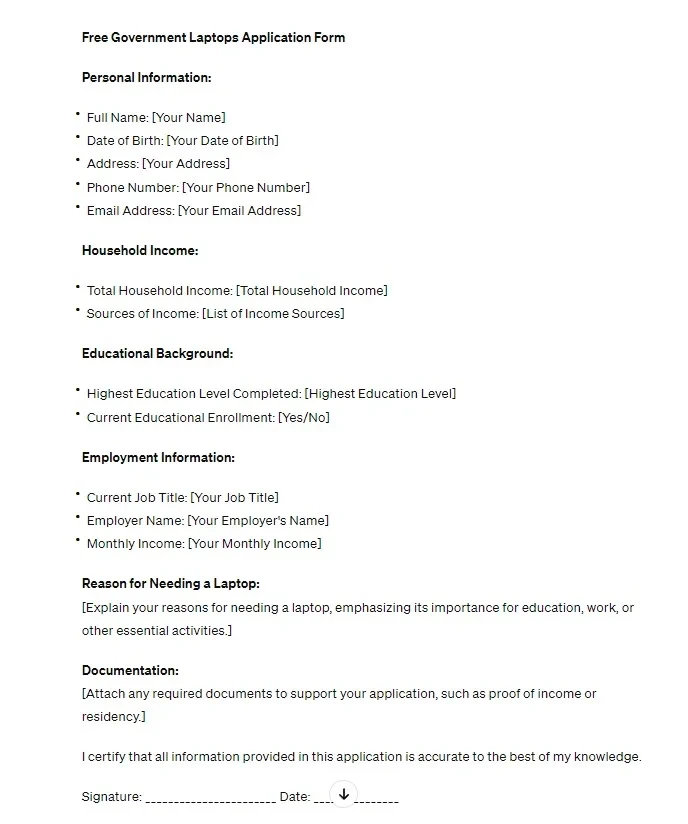SNAP Laptop Program: The Definitive Guide
The SNAP Laptop Program is designed to provide essential technology to low-income individuals and families. Many students and families face challenges in affording computers, which are crucial for education and career advancement. This program allows eligible SNAP recipients to acquire refurbished laptops at lower prices or with financial assistance.
In this guide, I’ll cover every aspect of the SNAP Laptop Program, including eligibility requirements, necessary documentation, and the application process. Additionally, I’ll share alternative ways to obtain free laptops from the government.

What is SNAP? A Brief Introduction
The Supplemental Nutrition Assistance Program (SNAP), managed by the USDA, is a vital government assistance initiative. Formerly known as the Food Stamp Program, SNAP helps low-income individuals and families purchase food from authorized retailers. It operates across all 50 states, the District of Columbia, and U.S. territories.
SNAP aims to combat hunger and promote nutritional well-being. According to Pew Research, approximately 42 million Americans, across 23 million households, receive SNAP benefits. These benefits are provided through EBT cards, enabling recipients to purchase nutritious food, which is critical for their health and security.
It may interest you:Free Laptops for Students Program 2025 [Online Registration]How to Apply for the SNAP Laptop Program?
Step 1: Research Available USDA Programs
Begin by exploring USDA programs available in your state. You can search online or contact local agencies for information.
Step 2: Check Eligibility Criteria
Review the eligibility criteria on the USDA website to determine if you qualify. Criteria include income limits, residency, and participation in specific assistance programs.
Step 3: Gather Required Documentation
Collect all necessary documents, such as income proof, identification, and evidence of participation in other assistance programs. Detailed requirements are listed on the USDA website.
Step 4: Submit an Application
Complete and submit an application form for the suitable program via the USDA website. Applications may be available online or at community centers.
Step 5: Attend Information Sessions (if required)
You might be asked to attend information sessions or workshops to understand the program better. Check the USDA website for such requirements.
Step 6: Wait for Application Processing
After submission, wait for the application to be processed. Processing times vary based on the program and application volume.

Step 7: Receive Approval Notification
If approved, you will receive a notification with instructions on how to access the resources or assistance offered.
Step 8: Attend Distribution Events (if applicable)
Sometimes, approved applicants need to attend events to collect their laptops and related technology. Details will be provided upon approval.
Step 9: Follow Program Guidelines
After receiving your laptop, ensure you adhere to the program guidelines, such as using the technology for educational or job-related activities.
Step 10: Provide Feedback (if requested)
Some programs seek feedback to improve their services. Share your experience if requested through the provided channels.
If your application is rejected, you can appeal the decision. Request a fair hearing within 90 days from the decision date.
Am I Eligible for the SNAP Laptop Program?
To be eligible for SNAP (Supplemental Nutrition Assistance Program) benefits, households typically need to meet both gross and net income limits. However, households with elderly or disabled members are only required to meet the net income limit. Additionally, some households may qualify based on their participation in other assistance programs such as TANF (Temporary Assistance for Needy Families) or SSI (Supplemental Security Income).
It may interest you:Free Government Laptop Program 2025Eligibility for the SNAP Laptop Program is determined by two main criteria:
- Income Limit
Households generally need to meet both gross and net income limits. However, households with elderly or disabled members only need to meet the net income limit. Income limits vary by household size and are adjusted annually. Specific limits apply to states like Alaska and Hawaii.
Gross income is total income before deductions, while net income is what remains after allowable deductions.
- Alaska SNAP Eligibility: Alaska Department of Health and Social Services
- Hawaii SNAP Eligibility: Hawaii Department of Human Services
For detailed information on the general eligibility requirements, you can refer to the official SNAP website: SNAP Eligibility.
- Work Requirements
Applicants must meet certain work requirements, such as registering for work, not voluntarily reducing work hours, accepting job offers, and participating in training programs. Able-bodied adults without dependents must work or participate in a work program for at least 20 hours a week. Exemptions apply to:
- Homeless individuals
- Seniors
- Veterans
- Children
- Former foster care youth
- Pregnant women
- Deaf and hard of hearing individuals
Students may avail specific exemptions provided by the SNAP Laptop Program.
Key tips to ensure eligibility:
- Boost your income: Explore legitimate ways to increase earnings within program rules.
- Participate in job training programs: This not only enhances your skills but may also meet SNAP work requirements.
- Pursue educational opportunities: Engaging in education can improve your eligibility.
Documentation Requirements for SNAP
To apply for the SNAP Laptop Program, gather the following documents:
- Identification: Valid ID such as a driver’s license, state ID, or passport.
- Proof of Income: Recent income statements or documents showing other income sources.
- Expense Proof: Documentation of monthly expenses like rent, utilities, and medical bills.
- Asset Information: Details of assets, such as property papers, bank statements, and vehicle registration.
- Citizenship or Immigration Status: Proof of citizenship or legal immigration status for all household members.
- Additional Documents: Any other documentation requested by the SNAP office, such as proof of disability or enrollment in other aid programs.
Confirm specific requirements with your local SNAP office to ensure accurate and complete submission.
Bonus Tip: Alternatives to the SNAP Laptop Program
If you don’t qualify for the SNAP Laptop Program, consider these alternatives:
Closing Statement and My Verdict
The SNAP Laptop Program offers a valuable opportunity for low-income individuals to access necessary technology for education and employment. This initiative aims to support underserved communities through government assistance and partnerships.
My Verdict: The SNAP Laptop Program is a pivotal step towards ensuring equitable access to technology. Its success hinges on effective implementation and accessibility.
